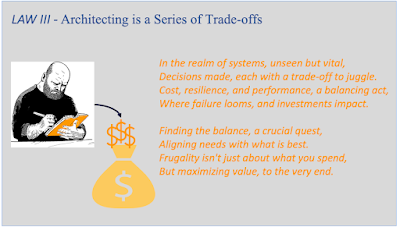Continuing our journey through "The FinOps Odyssey" series, we delve deeper into the principles of the Frugal Architect. Building on the foundation laid in Part 1, which explored the fundamental aspects mandating cost as a non-functional requirement driving efficiency and optimization, Part 2 takes us further into the realm of frugality in architecture. In this instalment, we focus on two key laws of the Frugal Architect, exploring how these laws can help align cloud cost to the business model and how architecting decisions can influence cost, performance and much more. Let’s apply it in real-world scenarios to achieve greater cost efficiency and operational excellence in the cloud.
LAW II - Systems that Last Align Cost to Business
Image generated with https://partyrock.aws/ for AWS Cloud Cost Optimization Theme
Dr. Werner’s Cloud FinOps Insights
The durability of a system depends on how well its costs are aligned to the business model. When designing and building systems, we must consider the revenue sources and profit levers. It’s important to find the dimension you’re going to make money over, then make sure the architecture follows the money.
For example, in e-commerce, that dimension might be the number of orders. When orders go up, infrastructure and operation costs rise. And that’s okay, because if your system is architected well, you can start to exploit economies of scale. What’s important is that infrastructure costs have a measurable impact on the business.
As builders, we need to think about revenue – and use that knowledge to inform our choices. Because growth at all costs leads to a trail of destruction.
(excerpt from https://thefrugalarchitect.com/)
Let’s delve deeper
· A system's longevity relies on its cost alignment with the business model.
· When designing systems, consider revenue sources and profit drivers.
· Identify the key metric for revenue generation and ensure the architecture supports it.
· For instance, in a software-as-a-service (SaaS) business, the key metric might be the number of active users. As the user base grows, infrastructure and support costs may increase. However, with a well-designed system, you can optimize resources and scale efficiently, leveraging economies of scale. The important factor is that infrastructure costs should align with the growth of the user base and directly contribute to the profitability of the business.
· Builders should prioritize revenue considerations to make informed decisions, as unchecked growth can have negative consequences.
Apply FinOps principles and AWS services
· Cost Alignment with Business Model: The FinOps principle of cost alignment emphasizes aligning costs with revenue and profit models. Attribute costs using your cost allocation process and tags. Tags provide showback to teams not directly responsible for costs, making them aware of their contribution. Perform chargeback to teams directly responsible for costs to recover expenses and raise awareness.
AWS Example:
· Showback and chargeback mechanisms, implemented through tools like AWS Cost Explorer, Cost and Usage Reports, and AWS Budgets, can help demonstrate how costs are allocated across different business units or projects.
· This transparency ensures that costs are aligned with revenue streams, promoting accountability and informed decision-making.
· By optimizing costs based on these insights, businesses can enhance the longevity and sustainability of their systems.
· Consider Revenue Sources and Profit Drivers: By aligning the system architecture with the primary revenue-driving metric, organizations can ensure that their technology infrastructure is optimized to support revenue generation and overall business success
AWS Example:
For an e-commerce application hosted on AWS with revenue sources including product sales and advertising, and profit drivers such as customer retention and average order value, the following AWS services can be used:
· Use Amazon RDS to manage your product database efficiently, ensuring high availability and scalability to handle peak loads during sales events. This can help in maintaining customer retention by providing a seamless shopping experience.
· Utilize Amazon CloudFront to deliver product images, videos, and other static assets to users with low latency and high transfer speeds.
· Implement Amazon SES for sending transactional and promotional emails to customers. Personalized emails based on customer behaviour can improve customer retention and increase average order value.
· Use Amazon Redshift to analyse customer data and gain insights into customer behaviour. This can help in targeting customers with relevant products and offers, thereby increasing average order value.
· Use Amazon Redshift to analyse customer data and gain insights into customer behaviour. This can help in targeting customers with relevant products and offers, thereby increasing average order value.
· Scale your application servers based on traffic demands using Amazon EC2. This ensures that your application remains responsive during peak traffic periods, leading to improved customer retention and increased sales.
· Use AWS Lambda for serverless computing to run code in response to events, such as processing orders or updating customer profiles. This can help in automating tasks and improving operational efficiency, contributing to increased profitability.
· Identify Key Revenue Metric:
· Identify the primary metric that drives revenue and ensure the system architecture supports it.
AWS Example: For an e-commerce site, the key revenue metric might be the number of transactions processed. AWS provides services like Amazon RDS for database management and Amazon EC2 for scalable computing, which can support the processing of a high volume of transactions.
· Prioritize Revenue Considerations:
· Builders should prioritize revenue considerations to make informed decisions.
AWS Example: AWS offers services like AWS Lambda for serverless computing, which can help reduce operational costs and improve efficiency. By prioritizing revenue considerations, developers can choose cost-effective AWS services that align with their revenue goals, ensuring sustainable growth and profitability.
A FinOps Odyssey
LAW III - Architecting is a Series of Trade-offs
Dr. Werner’s Cloud FinOps Insights
In architecture, every decision comes with a trade-off. Cost, resilience, and performance are non-functional requirements that are often at tension with each other.
As the saying goes, “Everything fails, all the time.” Being able to defend against failure means investing in resilience, but performance may pay the price.
It’s crucial to find the right balance between your technical and business needs – to find the sweet spot that aligns with your risk tolerance and budget. Remember, frugality is about maximizing value, not just minimizing spend. And to do that, you need to determine what you’re willing to pay for.
(excerpt from https://thefrugalarchitect.com/)
Let’s delve deeper
- Architecture decisions involve trade-offs between cost, resilience, and performance.
- Resilience requires investment but may impact performance.
- Balancing technical and business needs is essential for cost-effectiveness.
- Frugality is about maximizing value, not just minimizing spend.
Apply FinOps principles and AWS services
Applying the FinOps Foundation principles to architecture decisions involves a careful balancing act between cost, resilience, and performance.
AWS provides a range of services that can help achieve this balance:
- Cost-Effective Architecture:
FinOps Principles:
Implement cost allocation tags as per the FinOps Framework to categorize and track costs based on business attributes, helping align technical decisions with business priorities.
AWS Example:
- AWS Cost Explorer and AWS Budgets help monitor and optimize costs by providing insights into usage patterns and cost trends.
- AWS Trusted Advisor offers recommendations for cost optimization based on best practices and AWS architecture.
- Resilient Architecture:
FinOps Principles:
Use the FinOps Framework's resilience principles to design architectures that are resilient to failure, ensuring high availability and fault tolerance.
AWS Example:
- AWS Auto Scaling automatically adjusts the number of instances in a scalable manner to maintain performance and optimize costs.
- AWS Elastic Load Balancing distributes incoming traffic across multiple targets to ensure high availability and fault tolerance.
- Performance Optimization:
FinOps Principles:
Apply the performance optimization guidelines from the FinOps Framework to ensure that your systems are optimized for performance without compromising cost-effectiveness.
AWS Example:
· AWS Lambda enables serverless computing, allowing you to run code in response to events without provisioning or managing servers. This can lead to cost savings and improved performance.
- Amazon CloudFront delivers content with low latency and high transfer speeds by caching content at edge locations close to end-users.
- Balancing Technical and Business Needs:
FinOps Principles:
Utilize the FinOps Framework's principles for balancing technical and business needs to make informed decisions that align with both technical requirements and business priorities.
AWS Example:
- AWS Cost Allocation Tags allow you to categorize and track costs based on business attributes, helping you align technical decisions with business priorities.
- AWS Organizations provides policy-based management for multiple AWS accounts, allowing you to allocate resources based on organizational requirements.
- Maximizing Value:
FinOps Principles:
Follow the FinOps Framework's guidelines for maximizing value to ensure that your cloud resources are providing the maximum value to your organization at the lowest cost.
AWS Example:
- AWS offers a wide range of services, such as AWS Lambda, Amazon S3, and Amazon DynamoDB, that are designed to provide high value at a low cost.
- AWS Cost Anomaly Detection uses machine learning to identify unexpected changes in your AWS cost and usage patterns, helping you optimize spending and maximize value.
By leveraging these AWS services and principles, organizations can design architectures that are cost-effective, resilient, and optimized for performance, while maximizing overall value.
A FinOps Odyssey
Stay tuned for Part – 3 of The FinOps Odyssey series











